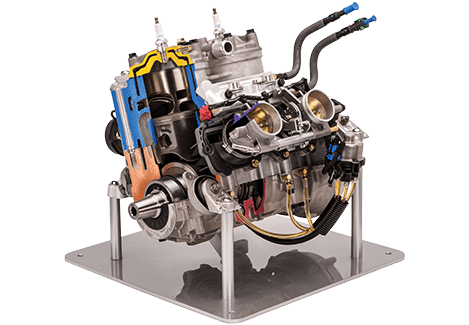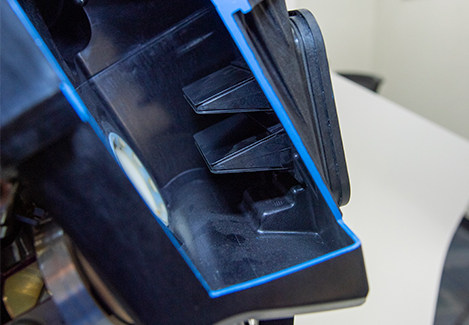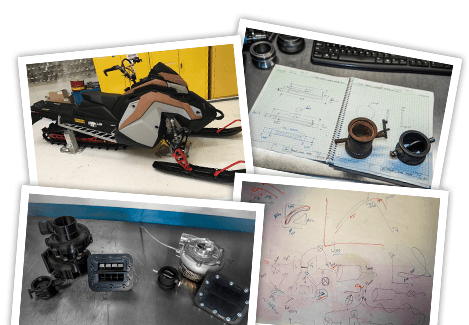
Building Boost Part 3: Patented Design
An Inside Look at Building The World's Most Powerful OEM 2-Stroke Turbo
When all was said and done, the Patriot Boost is comprised of 23 patent applications consisting of 52 unique disclosures, with 22 different inventors and contributors. Everything from the hardware to the control strategy utilized is unique and developed specifically for the project.
The foundation for the Patriot Boost is the Patriot 850 engine, largely unmodified for the Boost application. The Patriot 850 engine program started in 2014, representing the first true clean-sheet engine design from Polaris in nearly two decades. The engineering team had complete freedom in the design, and a clear ask from the riders – make it durable, responsive, and powerful.
“We set non-negotiables of industry-leading durability and response when delivering the Patriot 850. Keep the inertia low and make it responsive, while improving durability and refinement.” said Sampson.


Unknown to the industry at the 2018 launch, the 850 Patriot had also been purpose built for something else: boost. When building a new engine, one of the most important pieces is called design protection. In simple terms, it means designing the engine to not just work well now, but also in future applications further along the product plan. Mountain riders were asking for more power, and the Patriot 850 was designed from day one to be boosted.
The strong, low-inertia crankshaft is the core of what makes the 850 work so well. Low-inertia means more than just light weight – the strategic location of components, bearing designs, and more help the engine to rev up quickly, a key to keep the sled feeling light and agile. The 850 crank features a larger clutch taper and larger, double row roller bearings, all designed to centralize the mass.





The 6-bolt monoblock cylinder and head was all new for the 850, improving intake and exhaust flow through optimized port designs. The 3-stage VES exhaust valve system is a simplified co-planer valve that is lighter, improving the fit and seal with the piston to improve the control of the exhaust flow, ultimately providing better response and power. The 850 is fitted with an updated version of the Cleanfire SDI system, with a completely upgraded electronics and controls system that allows for better fuel economy and improved response through more exact fueling. Also baked into the new electronic system was all of the control and capability required for boost.
Performing extremely well as a naturally aspirated engine, the 850 Patriot handles the Patriot Boost package with virtually no modification – a testament to how well the engine itself is designed. Just a ringland reinforcement on the piston and auxiliary throttle body fuel injectors are the only additions for the boosted version.

Much in the same way the 850 Patriot was a clean sheet design, the Patriot Boost was purpose built from the ground up. When the team set out to build a reliable, high performance 2-stroke turbo, it was clear from the beginning that there was not an off-the-shelf solution. Patriot Boost would be designed completely in-house – and it was.
The magic of the Patriot Boost is a system called SmartBoost, a collection of proprietary patented hardware and software all focused around solving the issue of combustion stability.


The key to the SmartBoost system is the external wastegate mounted on the tuned pipe of the exhaust. The electronically actuated and controlled butterfly valve relieves the pressure of the tuned pipe and provides smooth air into the turbo, while providing ridiculously precise control. When the rider hits the throttle, the calibration of the engine identifies the target spot for the wastegate and electronic boost control to provide the right amount of boost to the engine. A slight variation in this boost delivery creates a bog or lazy response by the engine, making the snowmobile quite difficult to ride. An inconsistency between the fuel, timing, and boost pressure will result in engine instability and potentially detonation.
“We knew early on we had to focus on the control first” added Buchwitz. “We knew we needed a larger wastegate, but the velocity and force of the exhaust air was difficult to manage. When we started down the path of a balanced butterfly valve on the tuned pipe, the level of control it unlocked was unreal. It enabled us to move beyond just altitude compensating, and actually make 3 PSI of boost at sea level with rock solid durability.”

Anyone who has opened the side panels of a modern snowmobile can attest – it’s a tight fit, and space is at a premium. Long gone are the days of opening the clamshell hood, with all of the components laid out like a buffet line. When the Matryx RMK bodywork was early in development, it was clear from the start that the naturally aspirated and turbo versions would share common body work. That left the development team with a very large packaging challenge.
Throughout the development process, every hardware consideration had two questions: will it work, and will it fit. Hand building prototypes is one thing, but running a vehicle down a production line is a different challenge. Moreover, the further the weight moves outboard from the vehicle, the worse it handles. With the team unwilling to take any handling trade offs, a number of unique packaging designs and solutions were created.
The vertical turbocharger is also reverse rotating, where the turbo spins counterclockwise. This enabled the shortest airflow path possible, while keeping the weight down and the mass centralized on the sled.
“The entire turbo system was purpose built to be lightweight, compact, and efficient. The vertical orientation, aluminum water-cooled center section, reverse rotation turbine, everything was built to work extremely well for the specific application.” said Alex Hetteen, Powertrain Engineer.


The compressor and turbine have undergone significant optimization for the unique demands of a 2-stroke engine. The characteristics of a 2-stroke engine requires high mass air flow and lower boost levels. Countless compressor and turbine wheel inducers and exducers, blade counts and designs, and housings themselves were tested in pursuit of the perfect design. Extensive rotordynamics work was completed to ensure the optimum flow and performance for the specific 850 application, with strengthened internals to ensure stable, consistent operation. The result is a unique, patented turbocharger system that sets a new standard in 2-stroke performance. The system produces 3 PSI of boost at sea level, with up to 9 PSI of boost at high elevation - delivering unrivaled power.
While a lot less sexy than lightning fast boost response, proper turbocharger oiling and cooling is just as important. The patented turbo charger features a water-cooled aluminum center section, making it lighter than competitive turbos with better cooling properties to maintain optimum conditions. The vertical turbocharger orientation has some unique oiling requirements, in addition to the required use of 2-stroke oil.
The oil is delivered by a separate, dedicated oil pump that feeds only the turbo charger. This allows the turbo to have the precise amount of oil required at any time, regardless of engine oil demands. This oiling system features a unique check valve, ensuring the oil supply line retains oil and isn’t affected by long periods of not being run. The seals in the compressor and turbine are unique to the system, specifically designed to manage proper oiling in the vertical turbo.

With any turbocharged application, turbo lag is always a concern. The turbo needs exhaust gasses to spool and provide charged air back in to the engine, and the engine needs the charged air to make power. This cycle can create a lag in response time from squeezing the throttle to actual power delivery. Unwilling to take the compromise, the team set out looking for a unique solution. Sure, there were some high-end electronic turbocharger assist technologies in automotive, but none that had the weight and cost requirements needed for the snow application. They needed a lightweight, simple solution.
The result is a reed valve intake mounted right in the plenum, about three inches away from the throttle bodies. When the engine accelerates from low RPM or idle, the reed valve allows fresh air directly into the plenum, just like a naturally aspirated engine. The exhaust is allowed to build up boost while the response of the engine doesn’t suffer. Once adequate boost is delivered to the plenum, the air inside becomes pressurized, naturally forcing the reed valve shut. The lack of electronics or controls allows the system to be near immediate, with no transition hiccups as the engine comes on and off boost.
“The reed valve in the intake was all about getting as close to naturally aspirated response as we could, while maintaining really good driveability. The simplicity of the reed valve accomplished both.” added Buchwitz.
The Patriot Boost is truly an engineering marvel, resulting from a no stone unturned approach to development. Purpose built for the immense demands of ultra-high performance snowmobile riders all within the EPA’s regulations, it delivers performance that is unrivaled. 10% more horsepower than an 850 at sea level, and a whopping 50% more power at 10,000 feet of elevation in a reliable, high quality package, all while running 91 octane right straight out of the pump. Anyone who has gotten the chance to ride one can attest – it works damn well.










